Brügger & Thomet started out in 1991 in Thun, Switzerland as a sound suppressor manufacturer. In 2004, they started producing firearms. For a modestly sized company, well under a hundred employees, B&T produces an impressive variety of iconic small arms including submachine guns, bolt action and semiautomatic rifles, an integrally suppressed bolt action pistol, grenade launchers, as well as parts for other gun makers. Some of the designs are evolutions of older models, like Steyr TMP and Welrod, while others are largely original. Based in a very expensive country and manufacturing high quality arms, B&T asks a premium for its wares and usually gets it. Having worked with a Czech Bren 805 and FN SCAR, I got curious about an outwardly similar B&T APC223, a 5.56mm short-stroke pistol carbine aimed at the same military and police users as the other two. Expensive equipment can be either pro gear with maximized functionality or Veblen goods, where the excessive price itself bestows the cachet upon the purchase. Which of these is the APC223, the ultimate tool for the price, or a status symbol?
Is It Just Pretty, or Is It Also Highly Competent?
APC223 is available in the US in three forms: as a PDW with a 10.2-inch barrel length, a carbine with a 12.5-inch barrel, and a rifle model with a 16.5-inch barrel. I opted for the latter, as the cartridge benefits from the longer barrel for muzzle velocity and reduced blast, not to mention being a non-NFA item. The rifle came with a NATO spec flash hider threaded for B&T sound suppressors. A look at the furniture. For shooting off-hand, 12.5-inch barrel with the correspondingly shorter forend would have balanced slightly better but, for any kind of supported shooting, the longer barrel and forend are a clear win. The rifle is massively modular, with at least four stock options available.
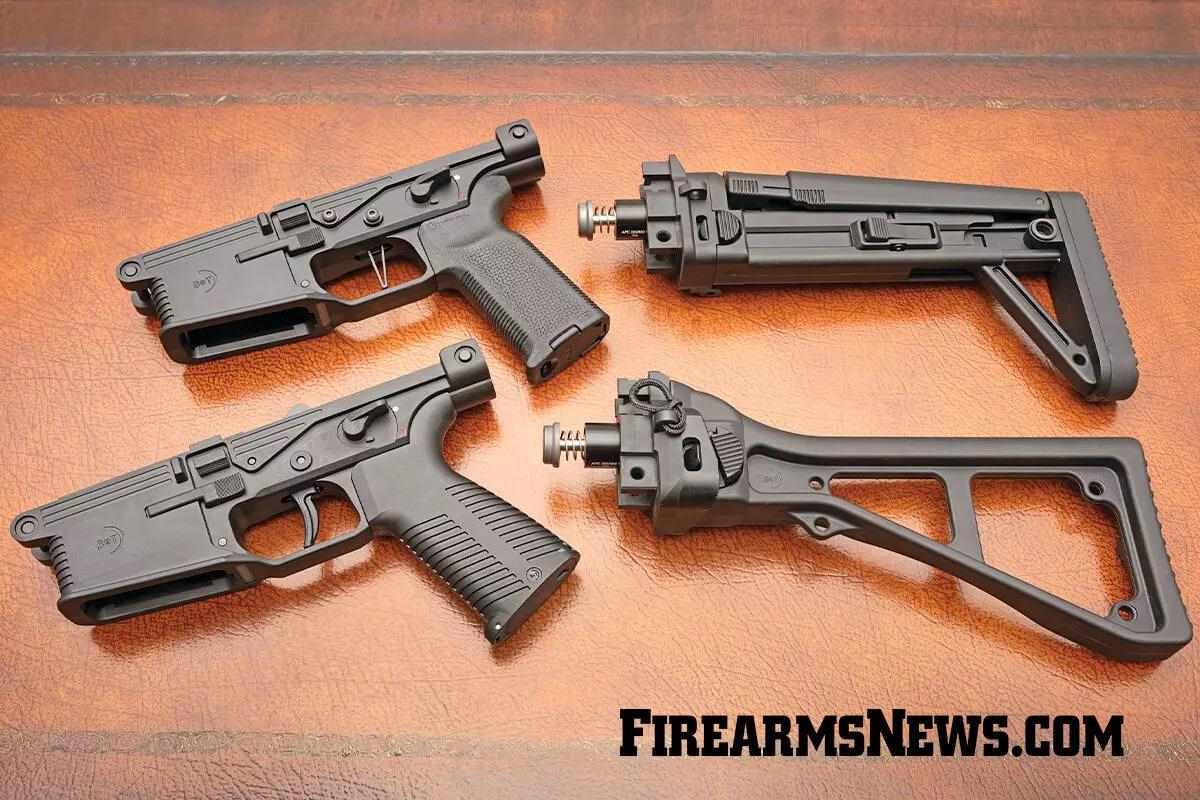
The same stocks may be used for rifles as for some of the submachine guns. The mostly-polymer lower receiver is not the regulated part in the US, rather it’s the extruded aluminum upper with steel inserts. It attaches to the upper with two captive pins. Pistol grips are of a standard AR-15 pattern. At 7.7 pounds unloaded, the APC223 is a little heavier than a comparable AR-15 — both use the same magazines, but that’s where the similarities end. APC223 uses a short stroke gas pistol action, with a convenient tool-less gas regulator for normal use, adverse conditions, and suppressed use. The positions are marked in millimeters of gas port diameter, 1.4, 1.5, and 1.0.
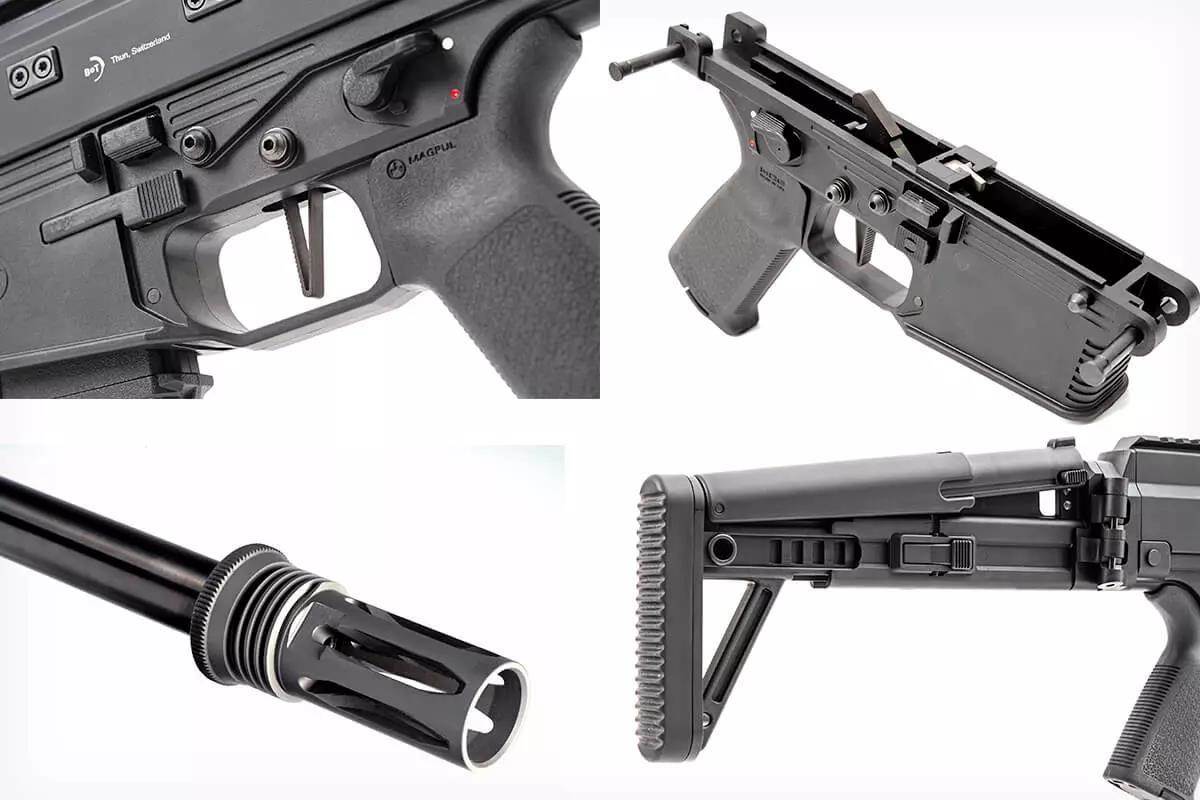
In addition to the standard recoil spring, the rifle uses a short hydraulic buffer in the buttstock extension. The extension fits in the receiver, enabling full functionality even with the stock folded to the right for transport. After seeing the stock in the stowed position, I understood why the cheek rest slants a little: that way, the folded stock clears the ejection port. The combination of spring and hydraulics gives this rifle recoil impulse comparable to a 10/22 rimfire. The rifle came with two lowers, one with the standard curved two-stage trigger, another with a straight single-stage Elfmann target trigger. The curved trigger (standard) breaks at five pounds, the straight one around 4.3 pounds (adjustable from 2.5 to 4.5 lbs.) but feels lighter thanks to being very crisp. Charging handles are folding flappers on both sides of the upper receiver. They do not reciprocate during firing but attach to a common internal carrier so both reciprocate when one is pulled manually. They can be activated by pushing against some fixed object, but only if the optic does not protrude to the side directly above them. I found that either handle worked well for loading the rifle, but the left side control was preferable for unloading: the right hand partly obscures the ejection port during the operation.
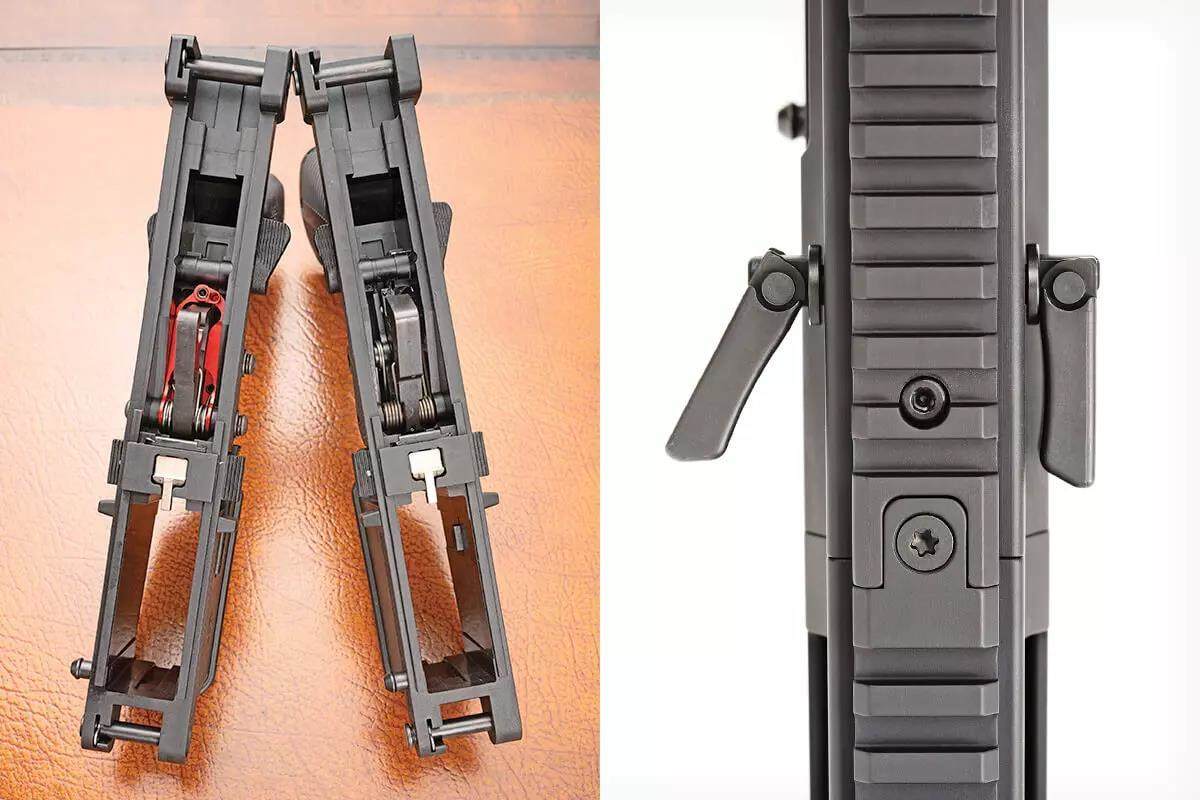
Other controls are also duplicated. The magazine release is the typical button forward and above the trigger guard, the bolt release also looks like a button but is actually a downward slider. The safety is a paddle with a 30-degree throw, short and narrow enough not to impinge on the thumb on the off-side, but long and wide enough for easy leverage. It is strongly and audibly detected. Ribbed safety lever also works as a “paddle” or resting surface for the thumb. The unlock button for the stock is very similar to SIG 550 design and in my opinion the best in the industry. It’s easy to operate but won’t unlatch by accident. I’ve tried two stocks, a fixed skeletonized model and the more adjustable MBT.
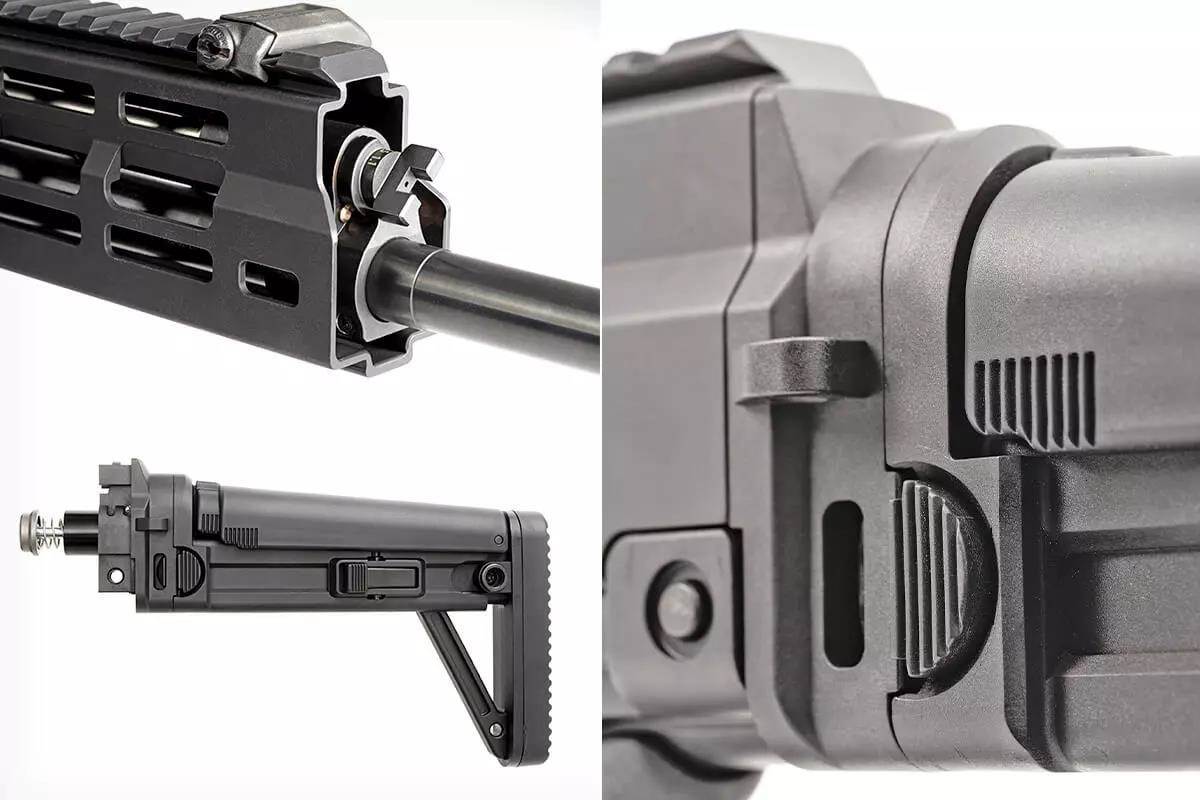
The fixed model looks more martial, has a plain ribbed plastic buttplate and is the stock to use with body armor. The MBT is adjustable for length with five positions, and for cheek rise, three positions. The riser is easy to adjust with one hand. Adjusting the length is a bit tricky as the release buttons are on both sides of the non-moving part of the stock. To extend, or collapse, you have to pinch them while pulling or pushing on the buttstock with another hand or some object. It’s an awkward design saved by being configurable and comfortable, with a thick rubber buttpad. Both stocks have small latches for metal sling hooks, the MBT also has QD sockets. The forend doesn’t have sockets, but one is easy to add using MLOK or Picatinny interface.
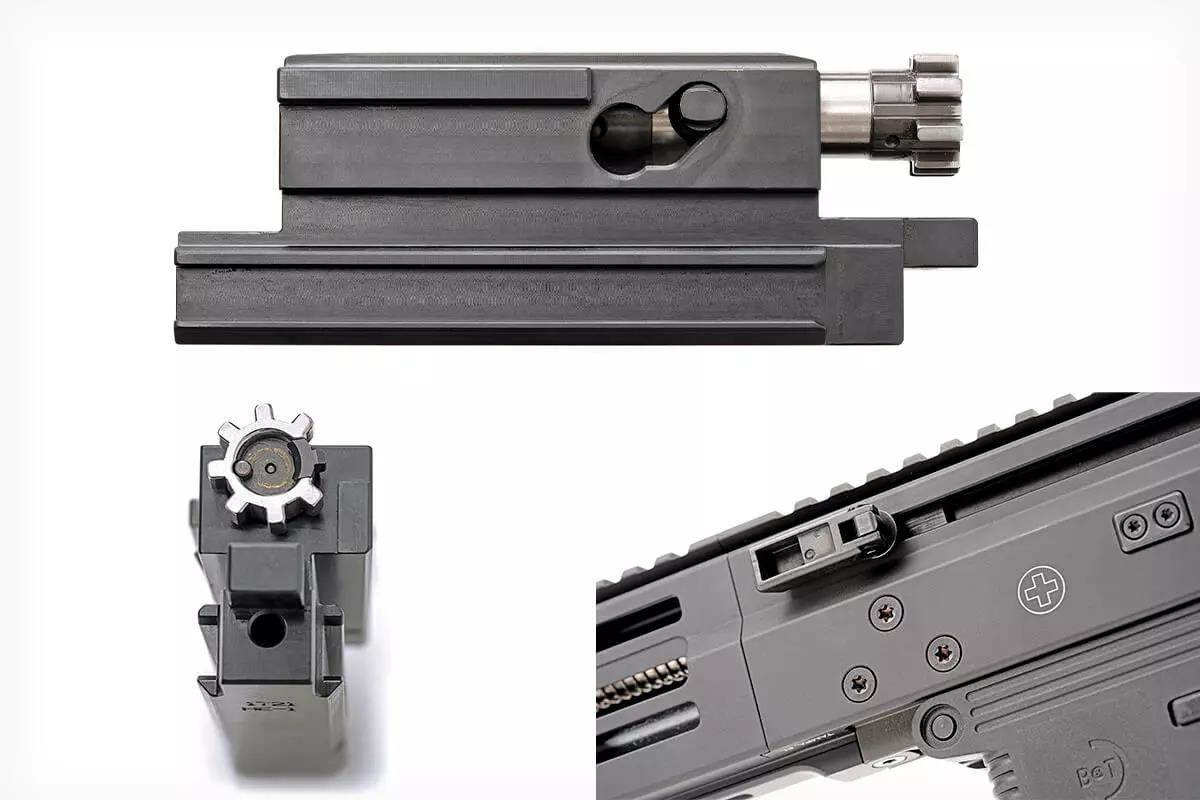
Gas adjustment is extremely simple. A punch or a bullet nose is needed to remove the gas regulator, but adjustments are tool-free. You might want to wear a glove if the regulator has to be switched to a larger port opening due to heavy fouling from high-volume shooting. Out of curiosity, I wrapped a paper towel around the forend and fired: some rifles blow soot at the support hand but not APC223. What little gas comes out of the regulator is directed forward over the muzzle. In general, this gun runs quite cleanly and stays cooler than a comparably configured AR-15. It also helps that the charging handle track is separate from the ejection port, and so doesn’t require cuts in the receiver behind the bolt which would have let dirt in near the bolt. Since there’s no left-side opening near the chamber, gas blowback, what little there is of it, is isolated away from the shooter’s face. Ejection intensity is quite underwhelming for shooters used to AR and AK vigor — brass arcs out slower and goes a foot or so to the right.
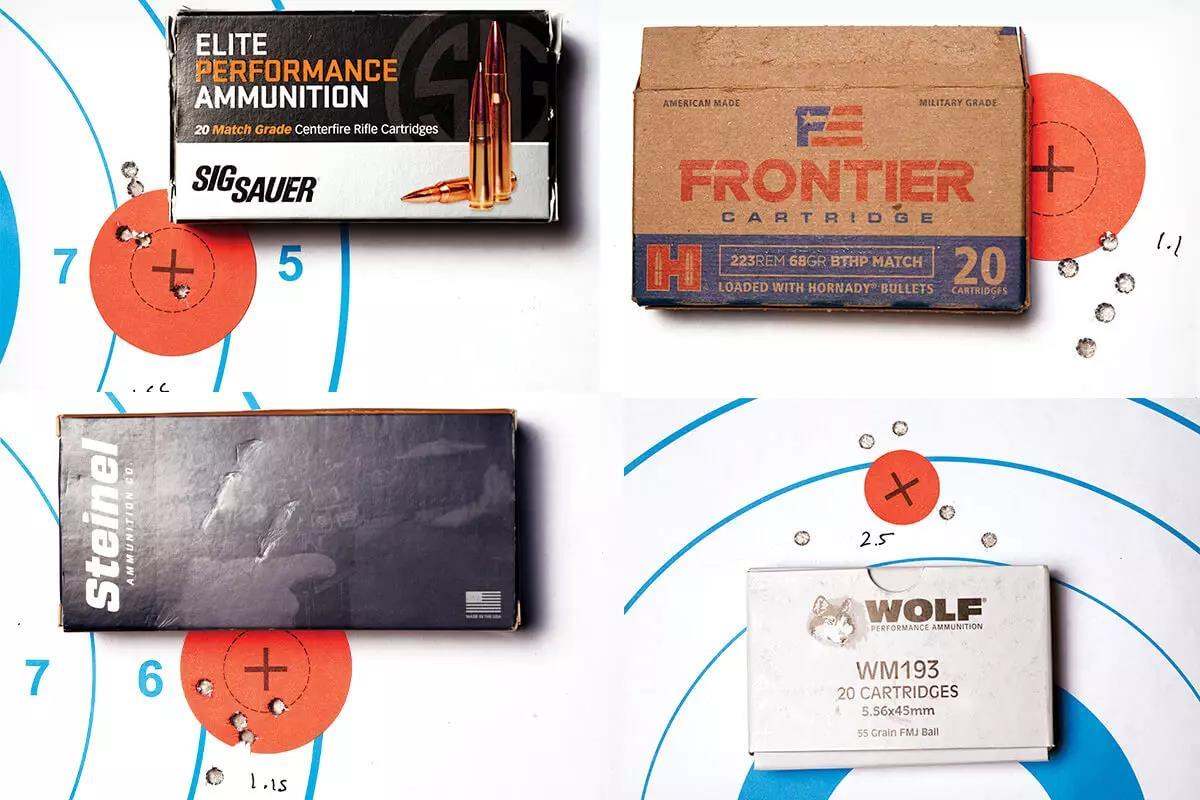
This is the result of a generally slower cycle duration, with cyclic rate around 550 rpm for APC556, the fully-automatic rifle version of APC223. The rotating multi-lug bolt and carrier are broadly similar to the AR-15. The ejector is a spring-loaded plunger. The entire assembly stays much cleaner though, thanks to the piston action. While the stocks are set up to allow fairly low optics, this gun can be used with AR-15-height fixed mounts. Picatinny rail sits about 1.75″ above the bore line, compared to AR-15 at 1.25″: it’s better to use medium rings rather than tall. The fixed stock works well with mini red dots and low-mounted scopes, while MBT stock gives the option of a comfortable sight picture with tall rings and fixed mount optics as well. B&T even offers a dip-down stock for shooting in a gas mask without having to resort to ridiculously tall scope risers. If I was running this rifle for defense, Aimpoint M5 red dot or similar would be my first choice.
On the Range
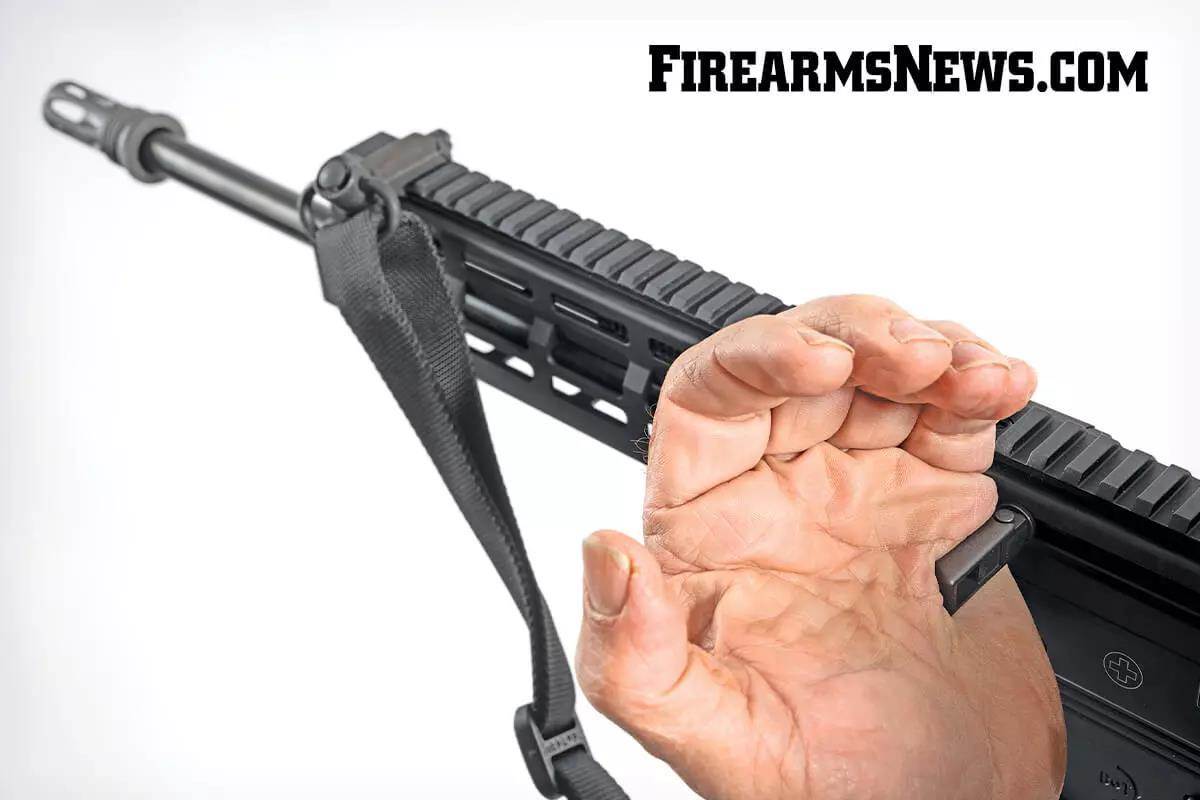
For testing accuracy and hunting, low-profile, variable-optic (LPVO) rifle scopes like the Vortex 1-6x give more options. Due to very generous eye relief of Vortex Razor HD, I put it far enough forward to bias the balance of the rifle toward the muzzle. That works great for supported firing but I would need more gym time to make this comfortable off-hand. In my opinion, a smaller 1-4x LPVO would make a better fighting optic for APC223. That said, the combination of the extra-clear Razor HD, the extra-crisp trigger, and the barely-extant recoil made this combination so easy to shoot that it was almost transparent to the user. In essence, I would look at a target, bring up the rifle and “clang” went head-size steel at 100 yards. The process conspicuously lacked a conscious effort of controlling the trigger or any anticipation of the shot. The hydraulic recoil dampener, combined with habits formed with over gassed AR-15- and AK-type guns, played a bit of a joke on me. When firing from a front sandbag, I used a looser hold on the gun than necessary, resulting in multiple accidental doubles as the entire rifle bounced forward. A second hit that’s several inches above the first one was of no use to me, so I switched to a more controlled hold and a tighter shoulder contact with the buttplate, which stopped double-taps.

I also discovered that the crosshairs of a 6x optic almost completely cover up one-inch target circles, requiring a switch to two-inch stickers. That adjustment out of the way, I learned that accuracy definitely depends on the ammunition in use, and heavier match loads are more consistent than ball. M855 Wolf ball spread averaged a fraction over three inches at 100 yards, 77-grain Norma match is pretty much MOA-accurate, except when I don’t do my part. 68-grain OTM Hornady Frontier averaged slightly over 1.5″, and Steinel 77-grain Match just about tied with SIG load of the same weight at 1.58″ and 1.67″ group averages respectively. Since 77-grain OTM bullets have respectable terminal performance, they would be my first choice for the bugout load. The ergonomics and the trigger make it easy to shoot APC223 to its full capability even under non-ideal conditions even for a mediocre marksman like me. I would have got slightly tighter groups with a higher-powered scope, but LPVO is more like what would be used on this rifle in a survival situation when hunting and self-defense are equally likely.
Conclusion

Compared to a SCAR, it feels better in the hand and seems to have less gas blowback. B&T’s silencer background shows in how well this rifle is adapted for sound-suppressed use. While SCAR parts are easier to find, B&T barrels actually cost only 2/3 as much. Compared to CZ Bren 805, it’s half-pound lighter and feels more refined, also displays better accuracy. They have similar features and level of support. The fit and finish on the APC223 is consistent with the Swiss reputation for quality. All three of these options cost much more than a typical AR-15, but not much more than a top-tier AR of comparable quality. Getting this rifle is a similar action to buying higher grade body armor: the nominal rating may be similar, but the comfort is greatly increased. For field use, APC223 has pluses and minuses. The pluses are the minimal recoil, good practical accuracy, excellent reliability, and high modularity for tailoring the weapon to the mission. The rifle uses the most common ammunition and magazines in the land.
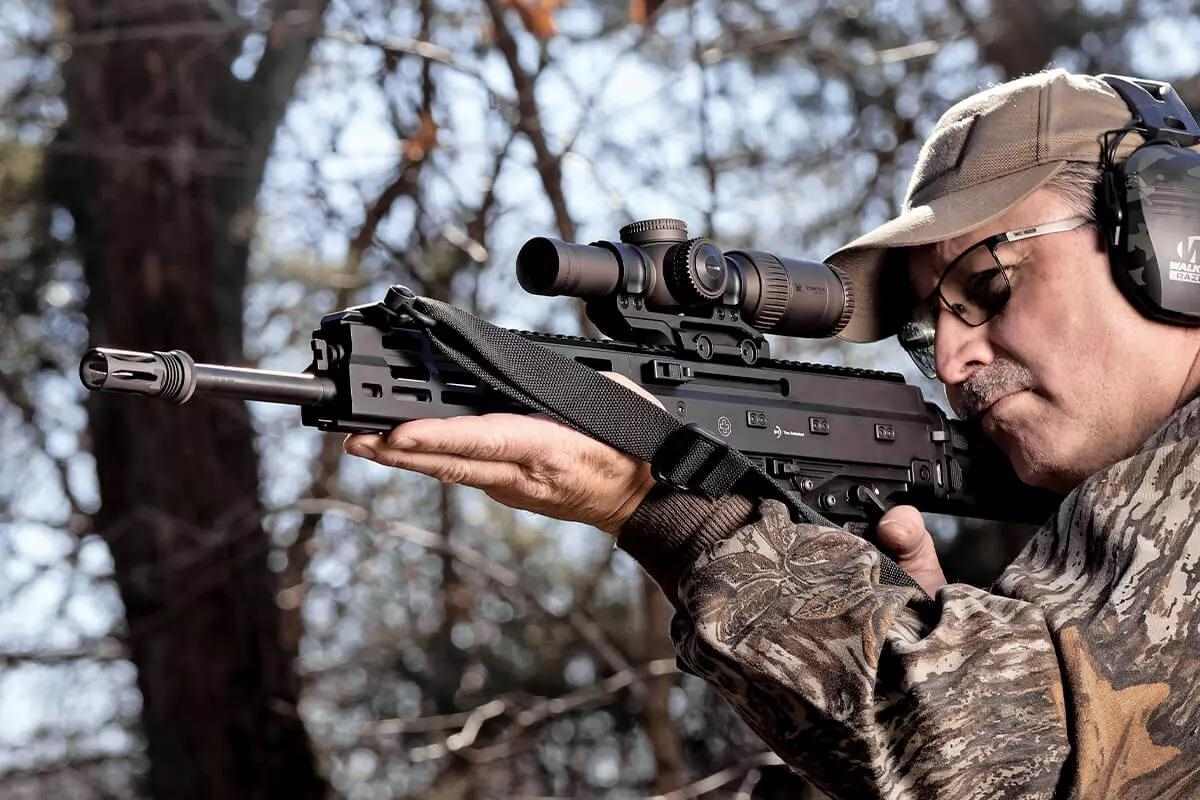
The only downside is the weight and the relative scarcity of spare parts and knowledgeable support compared to the more common models. This means, should you choose to go with APC223, a repair kit consisting of extra springs and small parts — or even an entire pre-assembled lower for the quickest possible repair — would be wise to have. Some of the parts would even fit inside the pistol grip. The other plus, often overlooked, is that practice with a weapon improves proficiency. Since this rifle is so pleasant and comfortable in use, you would want to practice with it as often as the ammunition supply and time availability allow. It’s that much fun to shoot.
Recommended
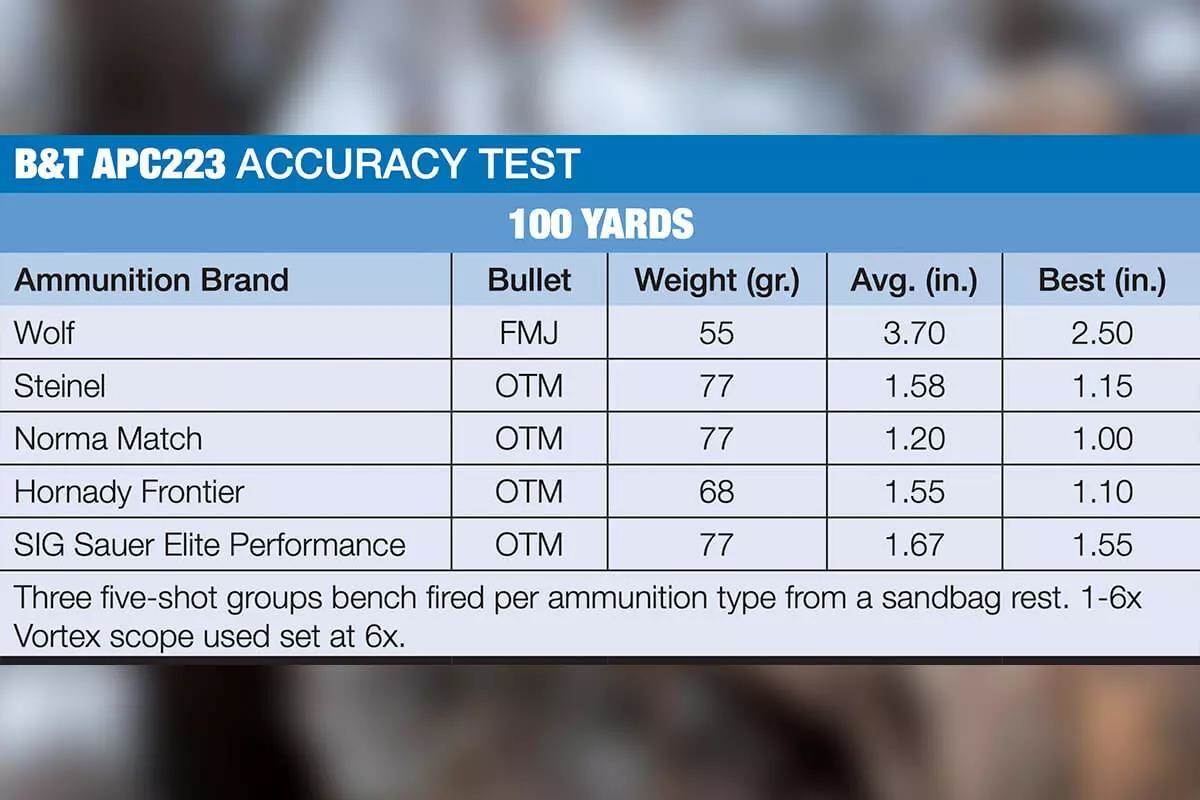
Brügger & Thomet APC223 Specs
- Part Number: BT-36068
- Caliber: 5.56x45mm
- Action: Semi-Auto
- Length: 38 in., 28 in. (folded)
- Barrel Length: 16.5 in. (419mm(
- Twist Rate: 1:7-in. twist
- Thread Pitch: 7.3 lbs.
- Finish: Black Type III hard coat anodized
- Material: Aluminum, steel
- Attachment Options: ROTEX
- MSRP: $3,400
- Contact: BT-USA
Read the full article here


